数据结构——堆
堆的基本知识
堆(Heap)是一种特殊的树状数据结构。
主要特性
- 堆通常是一棵完全二叉树。
- 堆中的每一个节点必须满足特定顺序要求,以这个要求分出大根堆和小根堆。
大根堆:任何一个父节点的值都大于或等于它的子节点的值。
小根堆:任何一个父节点的值都小于或等于它的子节点的值。
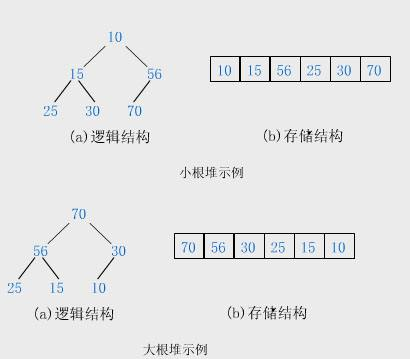
基本操作
- 插入(Insertion):在堆中添加新元素,同时保持堆的属性。
- 删除(Deletion):通常指的是删除堆顶元素,然后重新调整堆以保持其属性。
- 查找堆顶元素(Find Top):在最大堆中找到最大元素,在最小堆中找到最小元素。
- 堆调整(Heapify):将堆的某一部分重新调整,以恢复堆属性。
应用场景
- 优先级队列
- 堆排序
- 内存管理
实现方式
- 一般用数组实现
父子节点之间的索引:
1.父节点:i
2.左节点:2 * i + 1
3.右节点 2 * i + 2
4通过子节点i 找父节点 (i - 1)/ 2
堆的实现
堆的定义
typedef int HPDataType;
typedef struct Heap
{
HPDataType* arr;
int size;
int capacity;
}HP;跟我们定义顺序表类似,一个动态申请的数组、有效数据个数、最大可容纳数据个数。
堆的初始化
将arr置空,将capacity和size置0。
//堆的初始化
void HPInit(HP* php)
{
assert(php);
php->arr = NULL;
php->capacity = php->size = 0;
}堆的销毁
将动态申请的数组free掉,把capacity和size置0。
// 堆的销毁
void HPDestroy(HP* php)
{
assert(php);
free(php->arr);
php->capacity = php->size = 0;
}堆的调整
调整算法用于堆的插入和删除后恢复堆的属性,但是用调整算法的前提是堆原本是有序的(大根堆或者小根堆)
向上调整
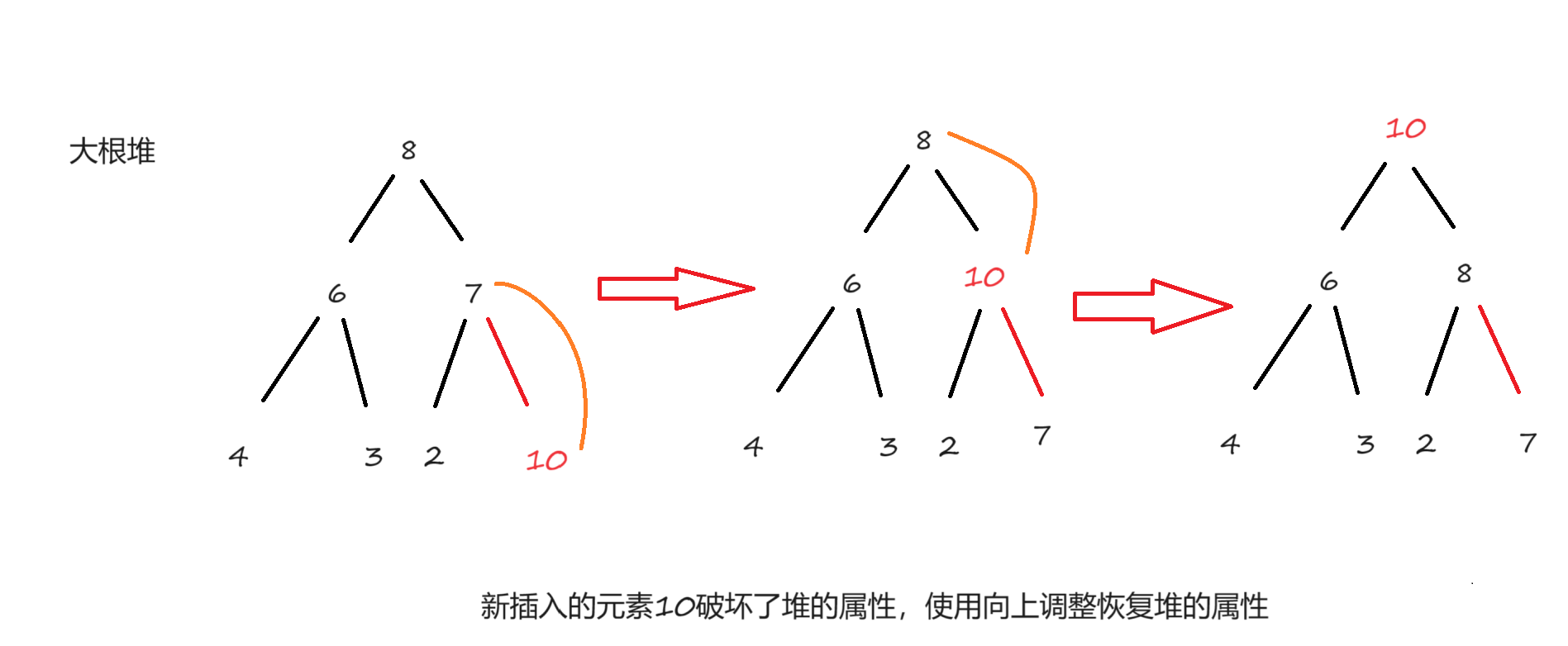
首先算出parent的索引,parent跟child比较,若child大于parent,则交换,然后更新parent、child,直到child小于等于0或者child小于parent了。
void AdjustUp(HPDataType* arr, int child)
{
assert(arr);
int parent = (child - 1) / 2;
while(child > 0)// parent >= 0 是错的 parent = (0 - 1) / 2 == 0
{
if (arr[child] > arr[parent])
{
//交换
Swap(&arr[child], &arr[parent]);
child = parent;
parent = (child - 1) / 2;
}
else
{
break;;
}
}
}
注意,循环条件不能用parent >= 0来判断,因为当child = 1,parent = 0时,child = parent后,child = 0,然后parent = (0 - 1) / 2 == 0,达不到理想终止的效果。(虽然最后循环也能停止,因为循环里arr[child] > arr[parent]不成立,break掉了,但是代码还是有问题的,要改正)
向下调整
向下调整与向上调整是类似的,但也有区别。
以大根堆为例,需要先找到左右孩子中较大的一个,再跟父亲比较。
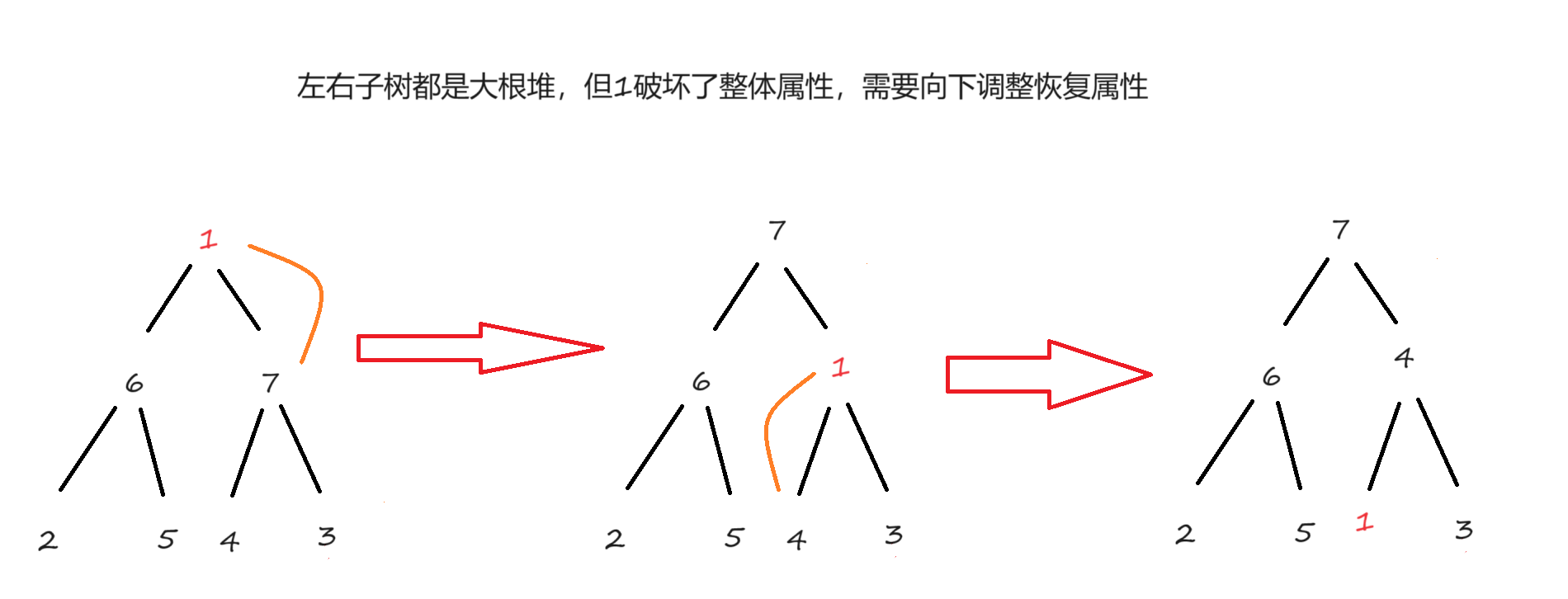
//向下调整
void AdjustDown(HPDataType* arr, int size, int parent)
{
assert(arr);
int child = 2 * parent + 1;
while (child < size)
{
//找两个孩子中较大的孩子 假设法 大的那个是左孩子
if (child + 1 < size && arr[child] < arr[child + 1])
{
child++;
}
if (arr[child] > arr[parent])
{
Swap(&arr[child], &arr[parent]);
parent = child;
child = 2 * parent + 1;
}
else
{
break;
}
}
}堆的插入
堆的插入只能尾插,不能随便插入到其他位置。
插入数据后使用向上调整恢复堆的属性。

//检查空间是否足够
void CheckCapacity(HP* php)
{
assert(php);
if (php->capacity == php->size)
{
int NewCapacity = (php->capacity == 0 ? 4 : 2 * php->capacity);
HPDataType* tep = (HPDataType*)realloc(php->arr, NewCapacity * sizeof(HPDataType));
if (tep == NULL)
{
perror("realloc fail!");
return;
}
php->arr = tep;
php->capacity = NewCapacity;
}
}
// 堆的插入
void HPPush(HP* php, HPDataType x)
{
assert(php);
//插入之前检查空间是否足够
CheckCapacity(php);
php->arr[php->size++] = x;
AdjustUp(php->arr, php->size-1);
}堆的删除
堆的删除是删除堆顶的数据,首先将堆顶数据和最后一个数据交换,让size--,然后使用向下调整算法恢复堆的属性。
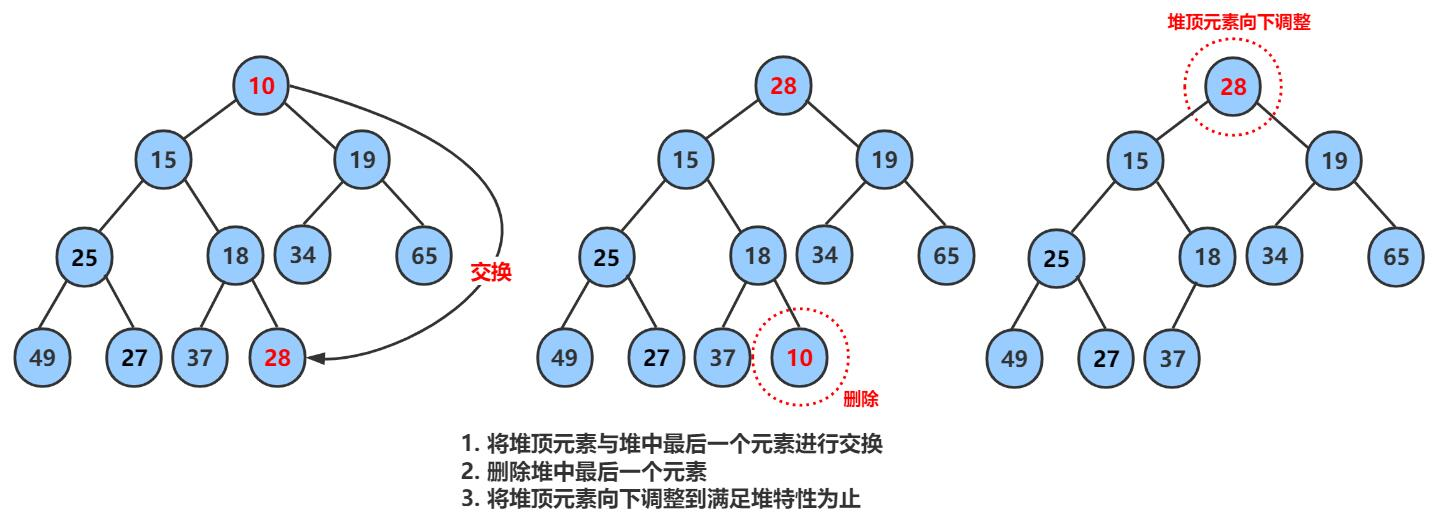
// 堆的删除 删除堆顶数据
//堆顶与尾交换 size-- 然后向下调整
void HPPop(HP* php)
{
assert(php);
assert(php->size > 0);
Swap(&php->arr[0], &php->arr[--php->size]);
AdjustDown(php->arr, php->size, 0);
}取堆顶的数据
注意判断堆不为空就行了。
//取堆顶的数据
HPDataType HPTop(HP* php)
{
assert(php);
assert(php->size > 0);
return php->arr[0];
}堆的判空
判断size == 0就行。
//堆的判空
bool HPEmpty(HP* php)
{
assert(php);
return php->size == 0;
}堆的应用
堆排序
堆排序主要利用堆的思想进行排序。
步骤:
1.建堆(升序建大堆;降序建小堆)
2.利用堆删除的思想来排序。(这也解释了为什么升序要建大堆,因为大堆确定了最大元素在堆顶)
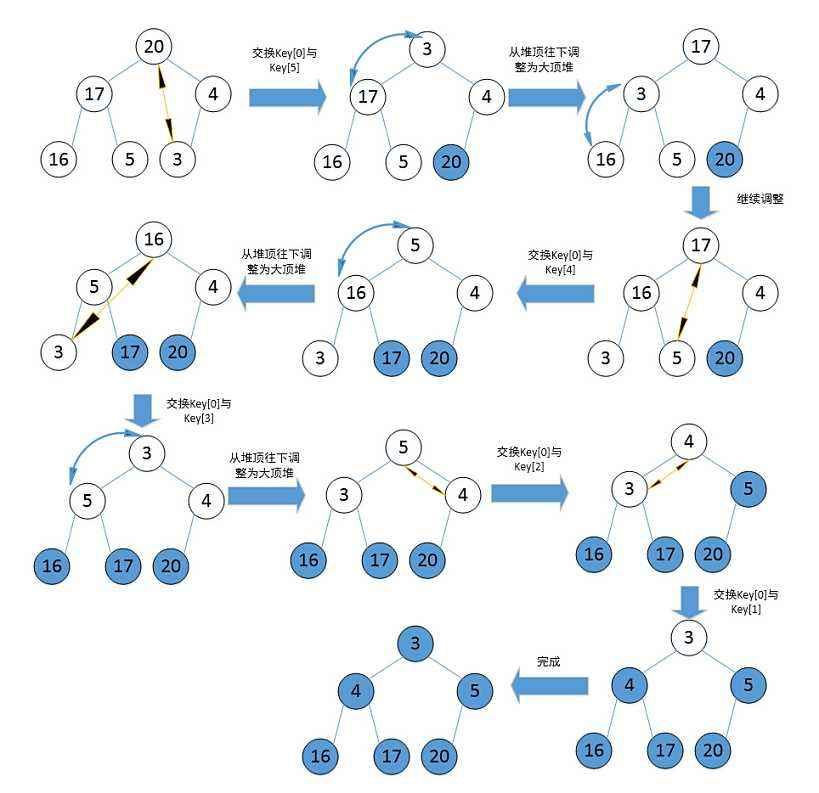
向下调整建堆
从最后一个非叶子节点开始,向上遍历直到根节点,对每个节点进行调整,以确保其满足堆的性质。
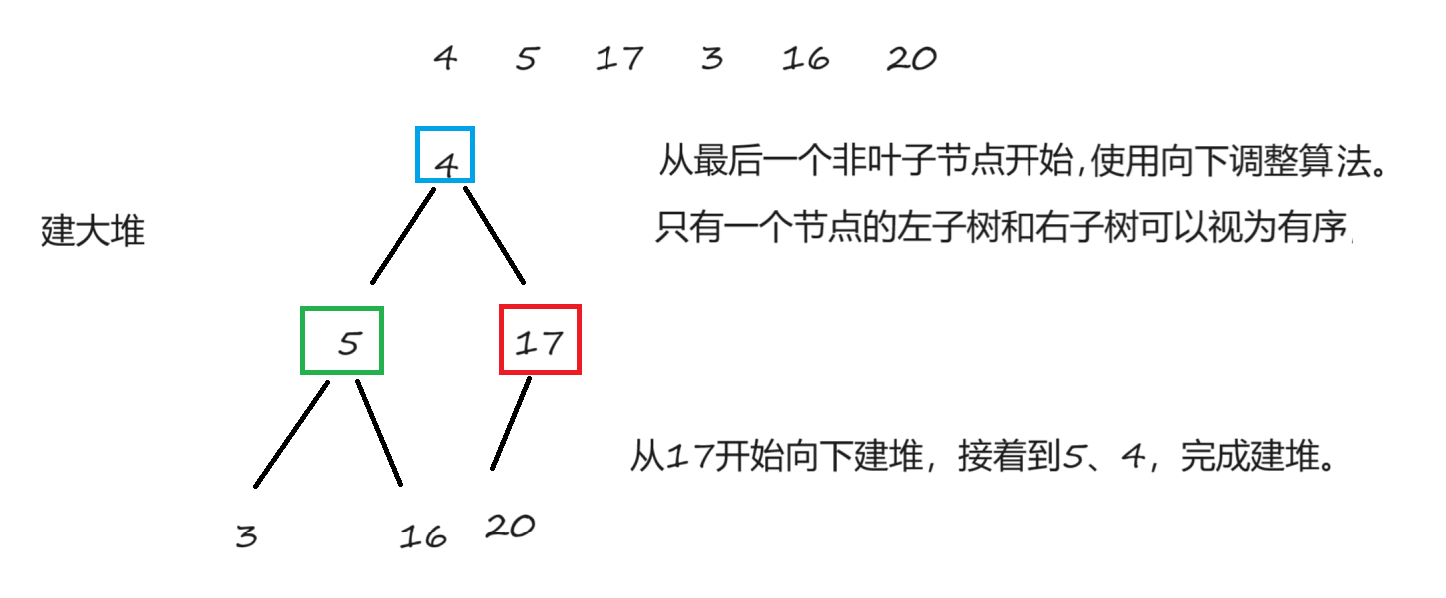
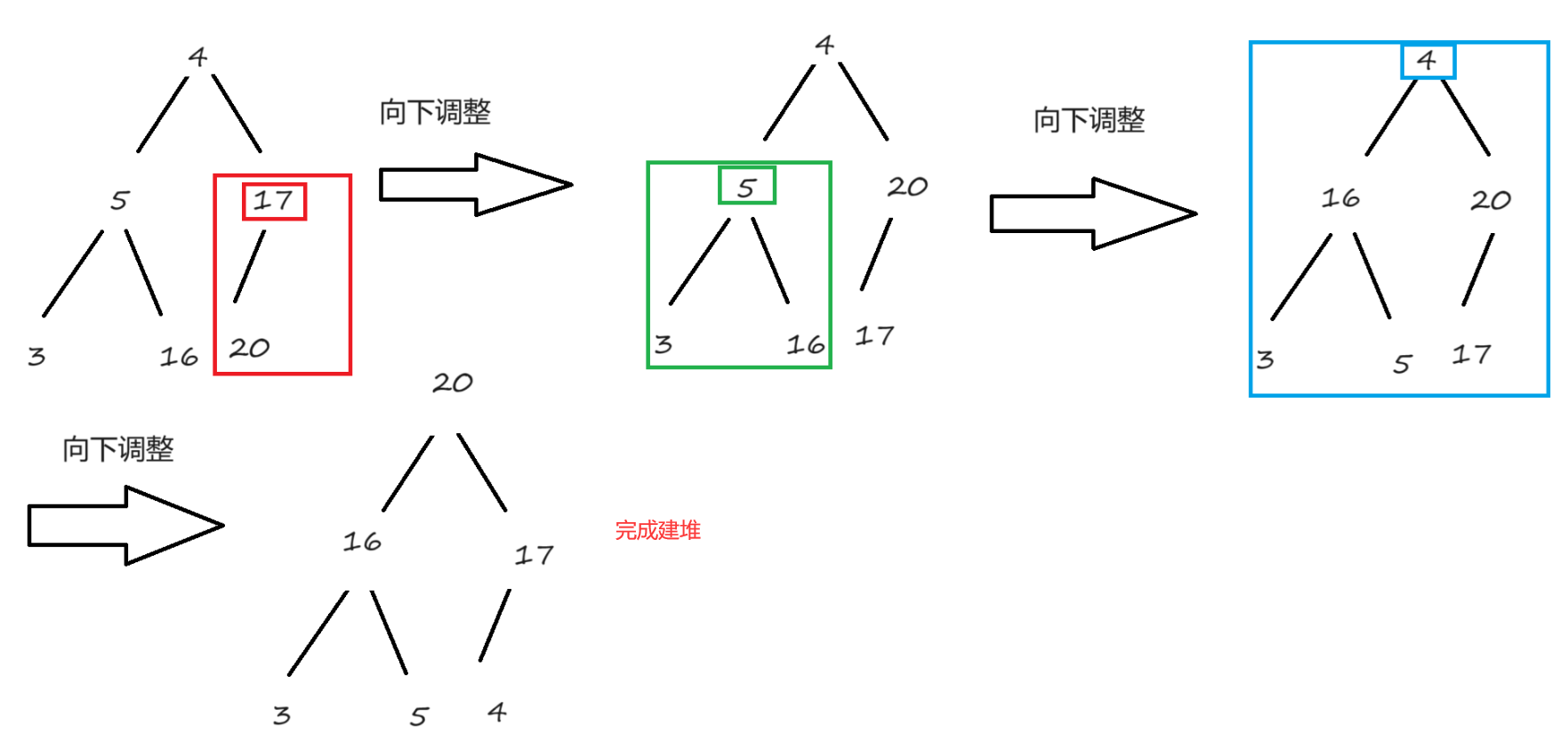
步骤:
- 从最后一个非叶子节点开始,该节点的索引为
n/2 - 1,其中n是数组的长度。 - 对每个节点,检查其子节点,如果存在违反堆性质的情况(在最大堆中,子节点大于父节点;在最小堆中,子节点小于父节点),则交换父节点和较大的子节点。
- 继续这个过程,直到节点满足堆性质或到达根节点。
void AdjustDown(int* arr, int size, int parent)
{
int child = 2 * parent + 1;
while (child < size)
{
//假设法找出左右孩子中大的那个节点
if (child + 1 < size && arr[child] < arr[child + 1])
{
child++;
}
if (arr[child] > arr[parent])
{
Swap(&arr[child], &arr[parent]);
parent = child;
child = 2 * parent + 1;
}
else
{
break;
}
}
}- 时间复杂度O(n)
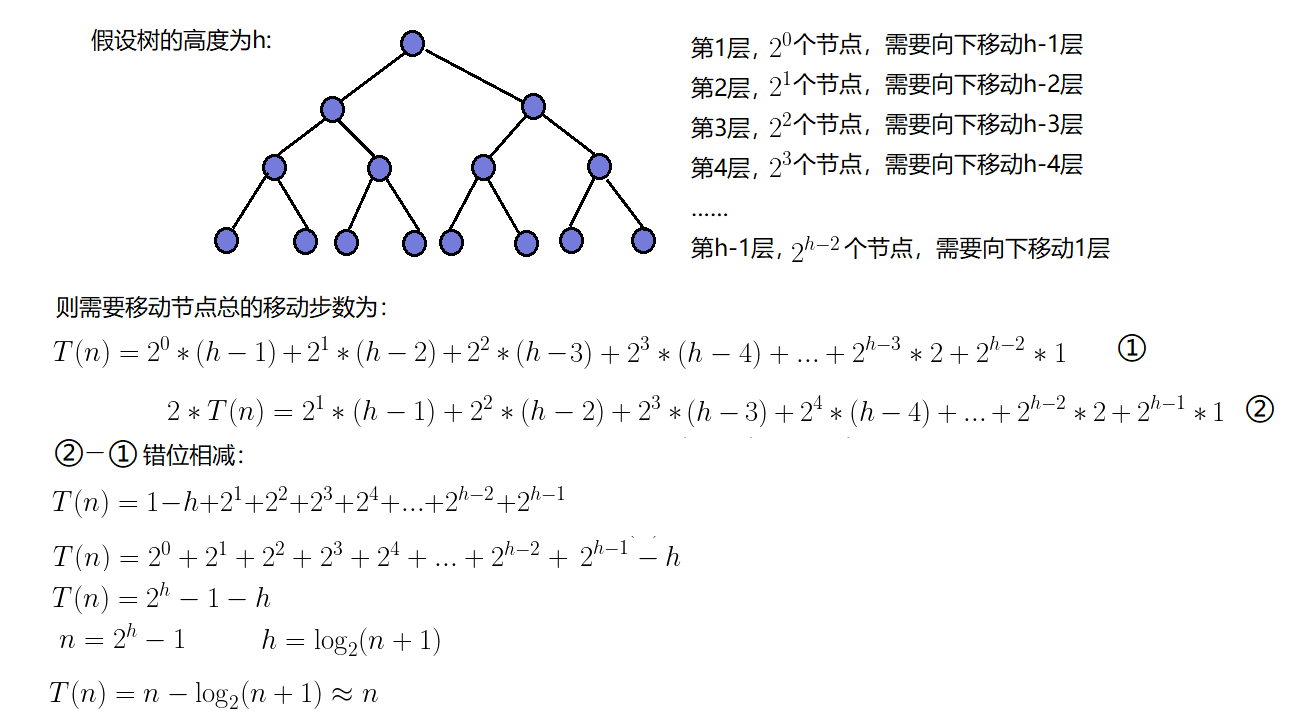
向上调整建堆
从第一个内部节点开始,向下遍历直到根节点,对每个节点进行调整。这种方法从底部开始,逐步向上调整节点。

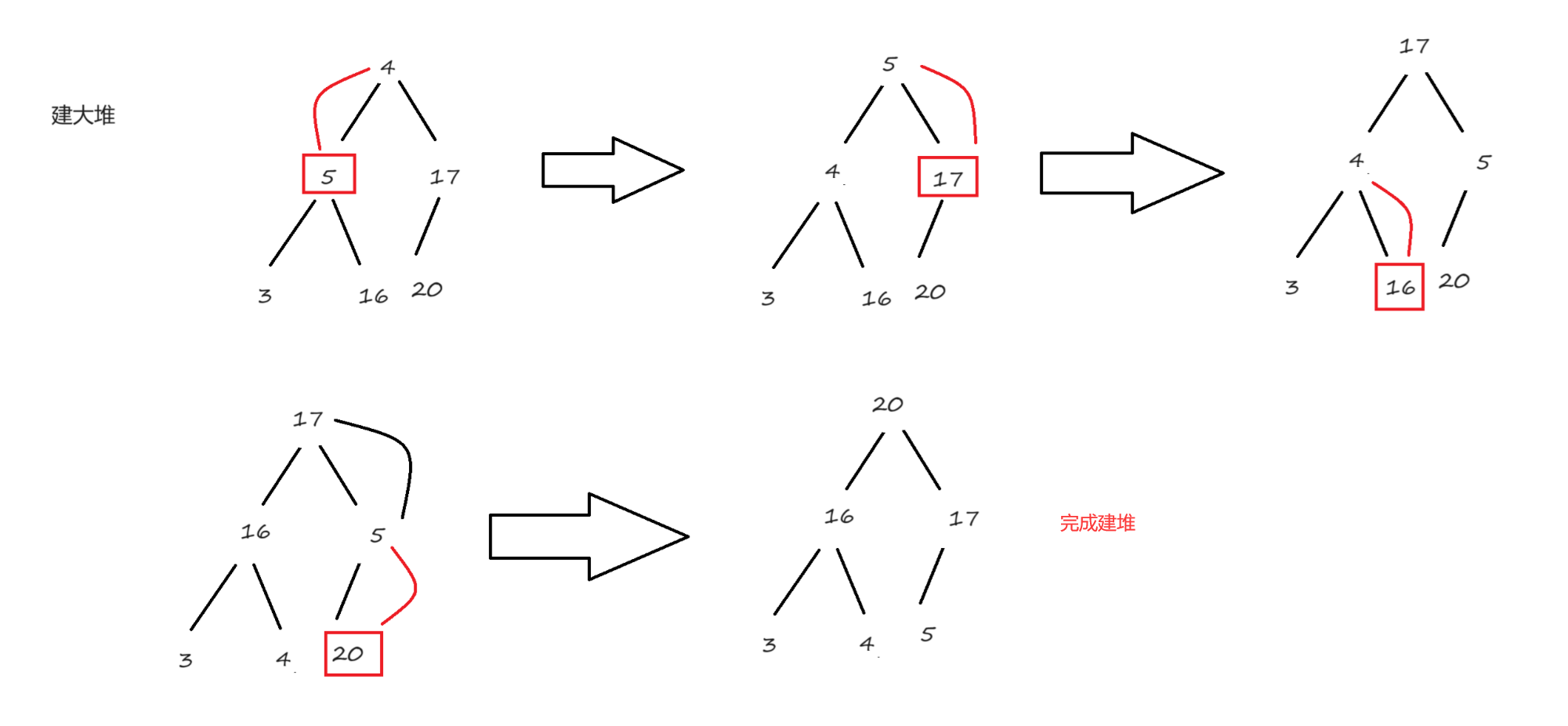
步骤:
- 从第一个内部节点开始,该节点的索引为
n/2,其中n是数组的长度。 - 对每个节点,检查其父节点,如果当前节点违反了堆性质(在最大堆中,当前节点大于父节点;在最小堆中,当前节点小于父节点),则交换它们。
- 将交换后的节点视为新的当前节点,重复上述过程,直到当前节点满足堆性质或到达根节点。
void AdjustUp(HPDataType* arr, int child)
{
assert(arr);
int parent = (child - 1) / 2;
while(child > 0)// parent >= 0 是错的 parent = (0 - 1) / 2 == 0
{
if (arr[child] > arr[parent])
{
//交换
Swap(&arr[child], &arr[parent]);
child = parent;
parent = (child - 1) / 2;
}
else
{
break;;
}
}
}- 时间复杂度O(nlogn)
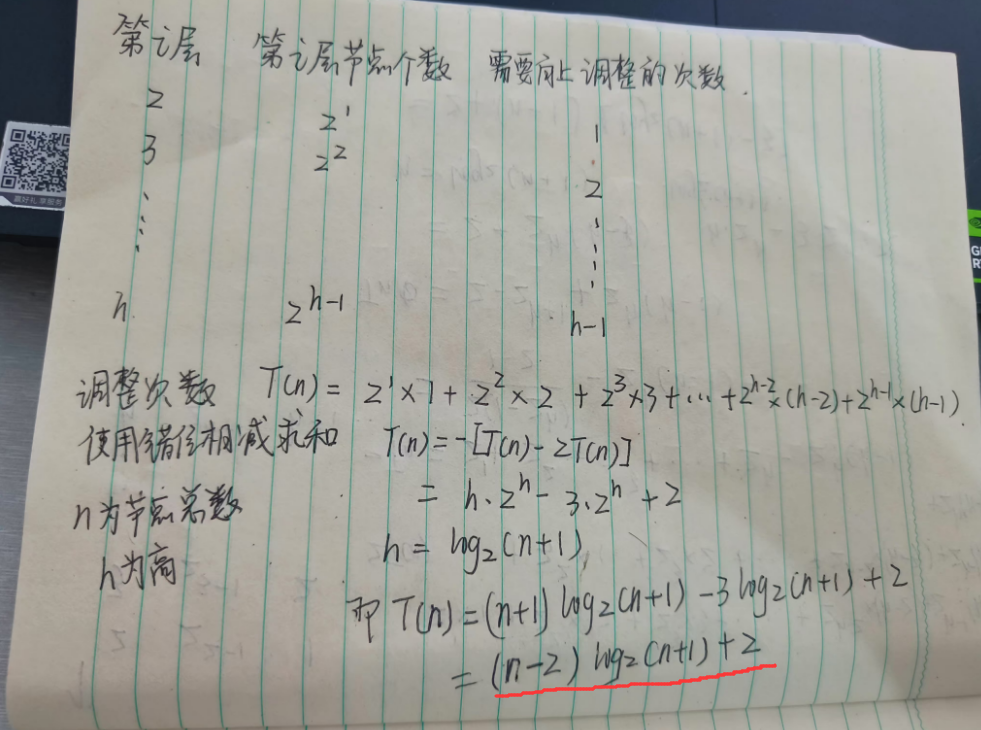
对比两种建堆方式,我们应当使用向下调整建堆。
利用堆删除来排序
当数组建堆建好后,交换堆顶元素和最后一个元素,缩小堆的范围,向下重新调整堆,重复此过程,直到堆的大小为1,说明数组已经排序好了。
void Swap(int* p1, int* p2)
{
int tep = *p1;
*p1 = *p2;
*p2 = tep;
}
void AdjustDown(int* arr, int size, int parent)
{
int child = 2 * parent + 1;
while (child < size)
{
//假设法找出左右孩子中大的那个节点
if (child + 1 < size && arr[child] < arr[child + 1])
{
child++;
}
if (arr[child] > arr[parent])
{
Swap(&arr[child], &arr[parent]);
parent = child;
child = 2 * parent + 1;
}
else
{
break;
}
}
}
void HeapSort(int* arr, int size)
{
//向下建堆
//升序 建大堆
//降序 建小堆
for (int i = (size - 2) / 2; i >= 0; i--)
{
AdjustDown(arr, size, i);//大堆
}
int end = size - 1;
while (end >= 0)
{
Swap(&arr[end], &arr[0]);
AdjustDown(arr, end, 0);
end--;
}
}堆排序的总时间复杂度是 O(n)(构建堆)+ O(nlogn)(堆排序过程),结果是 O(nlogn)。
- 时间复杂度:最好最坏都是O(nlogn)
- 空间复杂度:O(1)
拜拜,下期再见😏
摸鱼ing😴✨🎞



